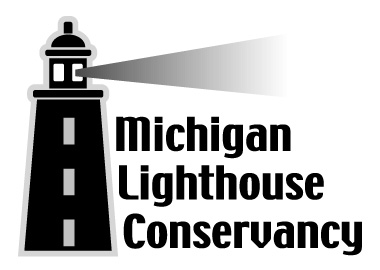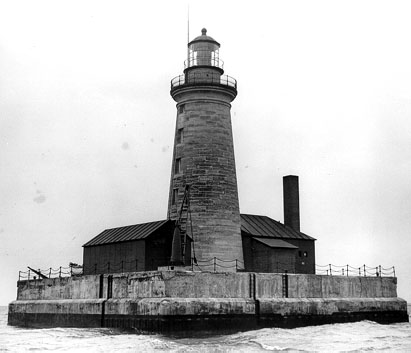|
SPECTACLE REEF LIGHT Location: STRAITS OF MACKINAC/LAKE HURON Year Station Established: 1870 Existing Historic Tower:
Previous Tower(s): Modern Tower? NO Existing Sound Signal Building? YES
Existing Keepers Quarters? YES
Other Structures: OIL HOUSE, STORAGE BUILDING Current Use: ACTIVE AID TO NAVIGATION Owner/Manager: U.S. COAST GUARD Open to the Public? NO Web Site: National Register Status: NONE Reference # 0 Miscellaneous: EARLY EXAMPLE OF EXPOSED CRIB |
The Spectacle Reef Lighthouse cost $406,000 and is the best specimen of monolithic stone masonry in the United States. The work on the lighthouse, which stands on a submerged limestone reef off the eastern end of the Straits of Mackinaw, was commenced in May 1870. It was planned and built by Maj. 0. M. Poe, who was General Shermanís chief engineer on his march to the sea. The light was first exhibited from the finished structure in June 1874. The available working time on the structure was, however, only about 20 months, because no work could be done on it during the winter months. The nearest land to Spectacle Reef is Bois Blanc Island, 1012 miles away. The stone for it was prepared at Scammonís Harbor, 16 miles distant and one of the items in its cost was the purchase of a steamer to convey the materials to the site. The waves at Spectacle Reef have a fetch of 170 miles to the southeastward and the ice fields, which are moved by a current and are thousands of acres in area, are often 2 feet thick. These had to be especially provided for because when they move in mass, they have an almost irresistible force. This force was overcome by interposing a structure against which the ice is crushed and by which its motion is so impeded that it grounds on the 7-foot shoal, which thereby forms a barrier against other ice fields. The tower, in the shape of a frustrum of a cone, is 32 feet in diameter at the base and rises 93 feet above the base, which is 11 feet below the water. The focal plane is 4 feet 3 inches above the top of the parapet, making it 97 feet 3 inches above the top of the submerged rock and 86 feet 3 inches above the surface of the water. For 34 feet up the tower is solid and from them on up it is hollow. In it are five rooms, one above the other each 14 feet in diameter, with varying heights. The walls of the hollow portion are 5 feet 6 inches at the bottom, tapering to 16 inches at the spring of the cornice. The blocks of stone below the cornice are 2 feet thick, and those of the solid portion of the tower are cut to form a lock on each other in each course, and the courses are fastened together with wrought iron bolts 2 1/2 inches thick and 2 feet long. The tower is bolted to the foundation rock with bolts 3 feet long which enter the bed rock 21 inches, the other courses receiving the bolts for 9 inches. Each bolt is wedged at both ends, and the bolt holes, which were made with a diamond drill, after the stones were in place, are plugged with pure portland cement, now as hard as the stone itself. Hence the tower is, in effect, a monolith. The stones were cut at the depot at Scammonís Harbor, 16 miles away, and fitted, course by course, on a platform of masonry. The stones were so well prepared that a course could be set, drilled, and bolted in 3 days. The foundation, 11 feet under water, was laid in a cofferdam protected by a crib work of 12-inch timber, built upon ways at the depot, as a ship might have been, than launched and towed by a number of steamers to the reef and grounded on the site. This crib was 92 feet square and 24 feet high. This afforded a protected pond for the cofferdam, a landing wharf, and quarters for the men all 12 feet above water. The cofferdam was then pumped out until the bedrock was exposed and on this bedrock the masonry courses were laid. A severe gale in September 1872 did considerable damage, though only of a temporary character, exposing the east face of this crib at a point where it had not been sheathed to protect it from the ice during the winter. It swept away the temporary cribs and nearly destroyed the workmenís quarters. After the winter of 1873-74, when the keepers returned to the newly completed tower, they found the ice piled against it at a height of 30 feet, or 7 feet higher than the doorway, and they could not gain entrance until they had cut away the iceberg of which the lighthouse formed the core. The light now flashes alternately white and red, every 60 seconds, the white light being 400,000 candlepower and the red light 80,000 candlepower, both second-order electric, and visible for 17 miles. There is also a 100 candlepower white winter light which flashes every 5 seconds. An air-diaphone fog signal is also located at the station. |
|

